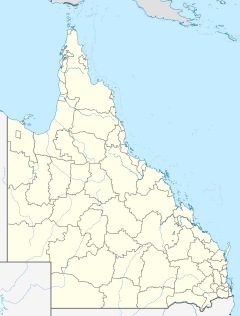
The Supreme Court of Queensland is the highest court in the Australian State of Queensland. It was formerly the Brisbane Supreme Court, in the colony of Queensland.

The Queen Street Mall is a pedestrian mall located on Queen Street in the centre of Brisbane, Queensland, Australia. The mall extends approximately 500 metres (1,600 ft) from George Street to Edward Street, and has more than 700 retailers over 40,000 square metres (430,000 sq ft) of retail space, which includes six major shopping centres. It was intended to bring more people into the central business district.
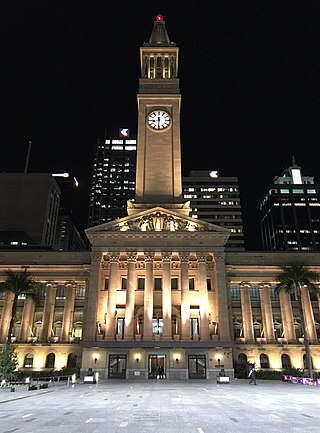
Brisbane City Hall, in Brisbane, Queensland, Australia, is the seat of the Brisbane City Council. It is located adjacent to King George Square, where the rectangular City Hall has its main entrance. The City Hall also has frontages and entrances in both Ann Street and Adelaide Street. The building design is based on a combination of the Roman Pantheon, and St Mark's Campanile in Venice and is considered one of Brisbane's finest buildings. It was listed on the Register of the National Estate in 1978 and on the Queensland Heritage Register in 1992. It is also iconic for its Westminster chimes which sound on the quarter-hour.

Queens Gardens is a heritage-listed park located on a city block between George Street, Elizabeth Street and William Street in the Brisbane CBD, City of Brisbane, Queensland, Australia. It was built from c. 1905 to 1990s. It is also known as Executive Gardens and St Johns Church Reserve. It was added to the Queensland Heritage Register on 21 October 1992.

The Treasury Building, previously known as the New Public Offices, is a heritage-listed former public administration building located at 21 Queen Street in Brisbane, Queensland, Australia. It was built from 1886 to 1928 for the Queensland Government. On 21 October 1992 the Italian Renaissance building was added to the Queensland Heritage Register.

The State Law Building, at 50 Ann Street, Brisbane, Queensland, Australia, contains offices of the Attorney-General of Queensland and other government organisations.

George Street is a major street located in the Brisbane CBD in Brisbane, Queensland, Australia.

John James Clark was an Australian architect, who began his career at the age of 14 in the office of the Colonial Architect's Office in Melbourne, immediately after his family migrated from Liverpool in 1852. Clark's 30 years in public service, followed by 33 in private practice, produced some of Australia's most notable public buildings, and at least one in New Zealand. He is most famous as the designer of Melbourne's Old Treasury Building aged only 19.

Adelaide Street is a major street in Brisbane, Queensland, Australia. It runs between and parallel to Queen Street and Ann Street.
Australian non-residential architectural styles are a set of Australian architectural styles that apply to buildings used for purposes other than residence and have been around only since the first colonial government buildings of early European settlement of Australia in 1788.

The District Court of Queensland(QDC) is the second tier in the court hierarchy of Queensland, Australia. The Court deals with serious criminal offences such as rape, armed robbery and fraud. Juries are used to decide if defendants are guilty or not guilty.
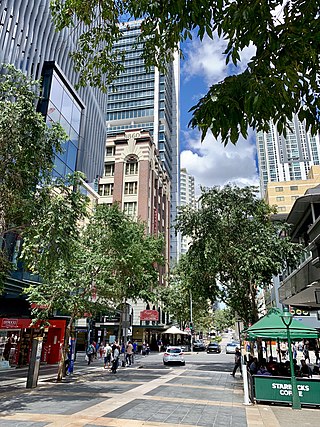
Albert Street is a street in the Brisbane central business district, Queensland, Australia. It was named after Prince Albert, the Prince Consort of Queen Victoria of the United Kingdom. Albert Street railway station is being built directly beneath the street and is expected to open in 2026. The station precinct includes partial road closures as planned in the 2014 City Centre Master Plan, for the creation of a new public space.
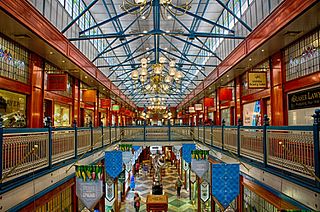
Brisbane Arcade is a heritage-listed shopping arcade at 160 Queen Street through to Adelaide Street in the Brisbane CBD, City of Brisbane, Queensland, Australia. Designed by Richard Gailey Jr. and constructed by J & E L Rees and Forsyth & Speering from 1923 to 1924, the arcade opened on April 16, 1924. It is the oldest and grandest shopping arcade in Brisbane. It was added to the Queensland Heritage Register on 21 October 1992.
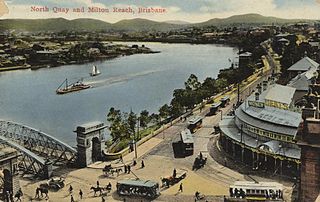
North Quay is a location in the Brisbane central business district and the name of a street in the same area, running along the Brisbane River from an intersection near Makerston Street to the top of the Queen Street mall, linking the Victoria Bridge and the William Jolly Bridge along the river's northern bank. It was the site of Brisbane’s initial settlement, at a point where a stream flowing from Spring Hill provided fresh water, later collected in a reservoir on Tank Street.

Charlotte Street is a road in the central business district of Brisbane, Queensland, Australia. The street is one of a number that were named after female queens and princesses of the royal family shortly after the penal colony was settled. Mary Street runs parallel to the south and Elizabeth Street is the next street to the north.

Lady Justice is an allegorical personification of the moral force in judicial systems. Her attributes are scales, a sword and sometimes a blindfold. She often appears as a pair with Prudentia.

The Queen Elizabeth II Courts of Law, also referred to as the Brisbane Supreme and District Court, is a court building located at 415 George Street in Brisbane, Queensland, Australia.

Sir Joseph Aloysius Sheehy KBE was an Australian jurist and Senior Puisne Judge of the Queensland Supreme Court. He also served as Administrator of the Government of Queensland in 1965 and 1969, and as Queensland's Lieutenant-Governor, Deputy Governor, Acting Governor and Acting Chief Justice on several occasions.

The Early Streets of Brisbane is a heritage-listed archaeological site at sections of Albert Street, George Street, William Street, North Quay, and Queen's Wharf Road in Brisbane City, City of Brisbane, Queensland, Australia. It was built from 1825 onwards. It was added to the Queensland Heritage Register on 16 July 2010.

The Moreton Bay Penal Settlement operated from 1825 to 1842. It became the city of Brisbane, Queensland, Australia.

